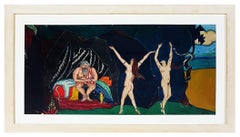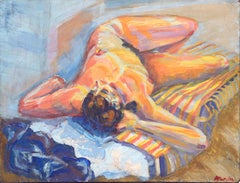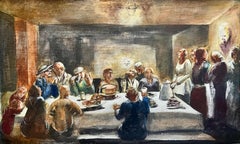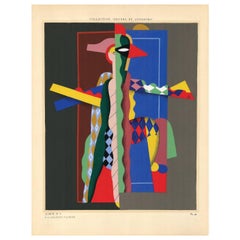Georges Valmier Art
to
1
1
1
1
Overall Height
to
Overall Width
to
1
1
1
1
1
1
1
6,934
3,285
2,514
1,213
1
1
1
Artist: Georges Valmier
The Temptation - Painting by Georges Valmier - Early 20th Century
By Georges Valmier
Located in Roma, IT
The Temptation is a modern artwork realized by Georges Valmier in the early 20th Century.
Mixed colored tempera painting.
Hand signed on the lower m...
Category
Early 20th Century Modern Georges Valmier Art
Materials
Paper, Tempera
Related Items
Modernist Reclining Female Nude Figurative
Located in Soquel, CA
Modernist reclining female nude figurative painting by an unknown artist (American, 20th Century). This vivid late 20th-century figural piece featur...
Category
20th Century American Modern Georges Valmier Art
Materials
Tempera, Masonite
Refreshment and Intermission
Located in Los Angeles, CA
This painting is part of our exhibition America Coast to Coast: Artists of the 1930s
Refreshment and Intermission, tempera on board, 11 x 19 inches, c. 1930/40s, signed lower middle, exhibited at Groom's one person show at Closson’s Gallery, Cincinnati, OH, March, 1943 (see The Cincinnati Enquirer, March 7, 1943, section 3, p. 4); provenance includes a private Ohio collection; presented in a period gold painted frame
About the Painting
Refreshment and Intermission is part of a series of paintings of Amish subjects Grooms started in 1938 based on his travels in Pennsylvania. These tempera works reflect the Regionalist impulse to paint local scenes far away from big cities. Focusing on both people and landscape, Grooms' compositions tell the stories of the uniquely American experience of the Amish. “Grooms paints the Amish people with as much understanding of type and appreciation of the plastic quality as any artist who has approached this challenging subject," noted the art critic for The Cincinnati Inquirer when reviewing Grooms' solo exhibition at Closson' Gallery, "In his current show, ‘Refreshment and Intermission,’ is a case in point. Here the absorbed concentration of people eating is described without an ounce of sentimentality. He has made the most of the interest between groups and of the conversations, both humorous and serious. The work has the quaint simplicity of a Lord’s Supper...
Category
1930s American Modern Georges Valmier Art
Materials
Tempera
Mural Study 1933 Depression Era Mid-Century WPA Modern American Scene Drawing
By Michael Loew
Located in New York, NY
Mural Study 1933 Depression Era Mid-Century WPA Modern American Scene Drawing.
Study to Scale Mural Sketch for “Evolution of Textile Production” East. All,...
Category
1930s American Modern Georges Valmier Art
Materials
Board, Egg Tempera
Russian French Judaica Jewish Gouache Painting Sephardic Rabbi, Jerusalem Israel
By Mane Katz
Located in Surfside, FL
Mané-Katz (1894 - 1962)
SCHOLARS AT STUDY
Signed Mané Katz (lower right)
Tempera (gouache) on paper laid down on card.
19 3/4 by 23 5/8 in. (50.2 by 60.1 cm) sight size.
Frame size is 27 X 31 inches.
Provenance: Sotheby's Impressionist & Modern art, 8 June 2017 (consigned by original owner who purchased it directly from artist)
Mane-Katz (1894-1962) was a Litvak painter born in Ukraine best known for his depictions of the Jewish shtetl in Eastern Europe. Emmanuel Mané-Katz (Hebrew:מאנה כץ), born Mane Leyzerovich Kats (1894–1962), was a Litvak painter born in Kremenchuk, Ukraine, best known for his depictions of the Jewish shtetl in Eastern Europe. Particularly music figures and Jewish wedding scenes.
Mane-Katz moved to Paris at the age of 19 to study art, although his father wanted him to be a rabbi. During the First World War he returned to Russia, at first working and exhibiting in Petrograd; following the October revolution, he traveled back to Kremenchuk, where he taught art. In 1921, due to the ongoing fighting in his hometown during the civil war, he moved once again to Paris. There he became friends with Pablo Picasso and other important French artists, and was affiliated with the art movement known as the School of Paris; together with other outstanding Jewish artists of that milieu, he is sometimes considered to be part of a group referred to specifically as the Jewish School of Paris. Includes Russian, Ukrainian and Polish painters Jankel Adler, Arbit Blatas, Marc Chagall, Jacques Chapiro, Michel Kikoine, Pinchus Kremegne, Sigmund Menkes, Jules Pascin, Issachar Ryback, Jacques Lipchitz,Chana Orloff, and Ossip Zadkine. Ecole de Paris
In 1931, Mane-Katz's painting The Wailing Wall was awarded a gold medal at the Paris World's Fair. Early on, his style was classical and somber, but his palette changed in later years to bright, primary colors, with an emphasis on Jewish themes. His oils feature Judaic Hasidic characters, rabbis, Jewish musicians, beggars, yeshiva students and scenes from the East European shtetl made famous in the west by Sholem Aleichem and Tevye.
Mane-Katz made his first trip to Mandate Palestine in 1928, and thereafter visited the country annually. He said his actual home was Paris, but his spiritual home was Eretz Yisrael, the Land of Israel. In 1939, as World War II was breaking out, he was drafted by the French and then was taken prisoner by the Germans. He escaped and went to the United States and remained there until 1945, exhibiting his paintings at Katia Granoff Gallery and Wildenstein Gallery. After the war, he returned to Paris where he had exhibited in the Salons. In Paris to the end of his career, he worked happily, painting hundreds of portraits of rabbis...
Category
Mid-20th Century Modern Georges Valmier Art
Materials
Tempera, Gouache
'Europa and the Bull', Greek Mythology, NYMOMA, Boston Museum of Fine Arts, PAFA
By Giglio Raphael Dante
Located in Santa Cruz, CA
Signed lower right 'Dante' for Giglio Raphael Dante (American, born 1916), titled verso and painted circa 1940.
Raphael Dante first studied at the Academy of Rome prior to moving to...
Category
1940s Modern Georges Valmier Art
Materials
Tempera, Paper
The Blue Top
By Robert Vickrey
Located in Boston, MA
Signed verso: "Robert Vickrey". Titled verso: "The Blue Top". In fine condition.
Category
Mid-20th Century American Modern Georges Valmier Art
Materials
Casein
St. Atomic oil and tempera painting by Julio de Diego
By Julio de Diego
Located in Hudson, NY
Julio De Diego’s Atomic Series paintings made an extraordinary statement regarding the shock and fear that accompanied the dawn of the nuclear age. In the artist’s own words, “Scientists were working secretly to develop formidable powers taken from the mysterious depths of the earth - with the power to make the earth useless! Then, the EXPLOSION! . . . we entered the Atomic Age, and from there the neo-Atomic war begins. Explosions fell everywhere and man kept on fighting, discovering he could fight without flesh.”
To execute these works, De Diego developed a technique of using tempera underpainting before applying layer upon layer of pigmented oil glazes. The result is paintings with surfaces which were described as “bonelike” in quality. The forms seem to float freely, creating a three-dimensional visual effect. In the 1954 book The Modern Renaissance in American Art, author Ralph Pearson summarizes the series as “a fantastic interpretation of a weighty theme. Perhaps it is well to let fantasy and irony appear to lighten the devastating impact. By inverse action, they may in fact increase its weight.”
Exhibited
1950 University of Illinois at Urbana "Contemporary American Painting"
1964 Marion Koogler McNay Art Institute, San Antonio, Texas
This work retains its original frame which measures 54" x 36" x 2".
About this artist: Julio De Diego crafted a formidable persona within the artistic developments and political struggles of his time. The artist characterized his own work as “lyrical,” explaining, “through the years, the surrealists, the social-conscious painters and the others tried to adopt me, but I went my own way, good, bad or indifferent.” [1] His independence manifested early in life when de Diego left his parent’s home in Madrid, Spain, in adolescence following his father’s attempts to curtail his artistic aspirations. At the age of fifteen he held his first exhibition, set up within a gambling casino. He managed to acquire an apprenticeship in a studio producing scenery for Madrid’s operas, but moved from behind the curtains to the stage, trying his hand at acting and performing as an extra in the Ballet Russes’ Petrouchka with Nijinsky. He spent several years in the Spanish army, including a six-month stretch in the Rif War of 1920 in Northern Africa. His artistic career pushed ahead as he set off for Paris and became familiar with modernism’s forays into abstraction, surrealism, and cubism.
The artist arrived in the U.S. in 1924 and settled in Chicago two years later. He established himself with a commission for the decoration of two chapels in St. Gregory’s Church. He also worked in fashion illustration, designed magazine covers and developed a popular laundry bag for the Hotel Sherman. De Diego began exhibiting through the Art Institute of Chicago in 1929, and participated in the annual Chicago Artists Exhibitions, Annual American Exhibitions, and International Water Color Exhibitions. He held a solo exhibition at the Art Institute of Chicago in the summer of 1935. Though the artist’s career was advancing, his family life had deteriorated. In 1932 his first marriage dissolved, and the couple’s young daughter Kiriki was sent to live with friend Paul Hoffman.
De Diego continued to develop his artistic vocabulary with a growing interest in Mexican art. He traveled throughout the country acquainting himself with the works of muralists such as Carlos Merida, and also began a collection of small native artifacts...
Category
1940s American Modern Georges Valmier Art
Materials
Masonite, Oil, Tempera
Ballerina dancer on vivid yellow and orange background
Located in Oostende, BE
Antoon Catrie (Ronsele, Belgium, 1924-1977), ‘Ballerina dancer’, oil on panel – tempera technique like in icons. The work is signed.
Category
Mid-20th Century Modern Georges Valmier Art
Materials
Wood, Tempera
H 15.95 in W 8.27 in D 0.79 in
Siamese Cat with Kittens by Orovida Pissarro - Egg tempura painting
By Orovida Pissarro
Located in London, GB
Siamese Cat with Kittens by Orovida Pissarro (1893-1968)
Egg tempera on linen
39 x 48 cm (15³/₈ x 18⁷/₈ inches)
Signed lower right Orovida and dated lower left 1934
Provenance
J Ankri, 8th October 1967
Literature
K L Erickson, Orovida Pissarro: Painter and Print-Maker with A Catalogue Raisonné of Paintings, (doctoral thesis), Oxford, 1992, Appendices, no. 51, p. 56 (illustrated)
Exhibition
London, The Leicester Galleries, Paintings by Orovida, February 1935, no. 6
Women’s International Art Club, 20th February - 13th March 1937, no. 273
London, Redfern Gallery, Ten Years of Work by Orovida, 5th-28th May 1938, no. 7
London, The Royal Society of British Artists, Summer Exhibition, 1947, no. 281 (possibly the etching)
London, O’Hana Gallery, Paintings, Drawings and Coloured Etchings: Orovida, 3rd-18th October 1957, no. 13
Artist biography
Orovida Camille Pissarro, Lucien and Esther Pissarro’s only child, was the first woman in the Pissarro family as well as the first of her generation to become an artist. Born in Epping, England in 1893, she lived and worked predominantly in London where she became a prominent member of several British arts clubs and societies.
She first learned to paint in the Impressionist style of her father, but after a brief period of formal study with Walter Sickert in 1913 she renounced formal art schooling. Throughout her career, Orovida always remained outside of any mainstream British art movements. Much to Lucien's disappointment she soon turned away from naturalistic painting and developed her own unusual style combining elements of Japanese, Chinese, Persian and Indian art. Her rejection of Impressionism, which for the Pissarro family had become a way of life, together with the simultaneous decision to drop her famous last name and simply use Orovida as a ‘nom de peintre’, reflected a deep desire for independence and distance from the weight of the family legacy.
Orovida's most distinctive and notable works were produced from the period of 1919 to 1939 using her own homemade egg tempera applied in thin, delicate washes to silk, linen or paper and sometimes embellished with brocade borders. These elegant and richly decorative works generally depict Eastern, Asian and African subjects, such as Mongolian horse...
Category
1930s Modern Georges Valmier Art
Materials
Linen, Egg Tempera
Parade
By Catherine Koenig
Located in Buffalo, NY
An original egg tempera painting by American female artist Catherine Koenig.
Category
1950s Modern Georges Valmier Art
Materials
Egg Tempera, Board
Migration (The Horses) by Orovida Pissarro - Painting of running horses
By Orovida Pissarro
Located in London, GB
*UK BUYERS WILL PAY AN ADDITIONAL 20% VAT ON TOP OF THE ABOVE PRICE
Migration (The Horses) by Orovida Pissarro (1893-1968)
Egg tempera on linen laid on board
76 x 101 cm (29 ⅞ x 39 ...
Category
1930s Modern Georges Valmier Art
Materials
Linen, Egg Tempera, Board
Have A Beer - Figurative Painting Yellow Brown Green Blue Pink White
By Yovana Dimitrova
Located in Sofia, BG
"Have A The Beer" is a figurative, romantic painting by Maestro Yovana Dimitrova,
She is an emerging artist.
About the artwork:
TECHNIQUE: Tempera painting
STYLE: Contemporary
Edition : Unique, signed
Weight: Approximately 3 kg.
“The impressions of Yovana's paintings on the viewer is perfection.
Her paintings bring emotion happiness, positive energy and make you think about the nowadays problems. This painting represent the vast creative power of her talent.”
Dear art lovers,
if you like the art of maestro Dimitrova, please click the link to follow this artist and art gallery Snow Pearl to discover all our artists and beautiful artworks.
Thank you so much! we appreciate your interest to our work.
Numerous artworks of the artist have been sold to galleries and individuals around the world
A certificate of authenticity of the artwork is delivered by Snow Pearl art gallery.
Category
2010s Modern Georges Valmier Art
Materials
Panel, Tempera
H 15.75 in W 11.82 in D 0.79 in
Previously Available Items
Collection Decors et Couleurs. Album No. 1. Pochoirs designed by George Valmier
By Georges Valmier
Located in New York, NY
VALMIER, Georges. Collection Decors et Couleurs. Album No. 1. Illustrated with 20 pochoir plates. Folio, issued loose in original tan portfolio, pochoir title on front board, with ties. Original tissue guards present. Paris: Aux Editions Albert Levy, 1930.
One of 100 copies. A perfect copy of this Art Deco port-folio of brightly coloured pochoir plates designed by the French painter Georges Valmier...
Category
1930s Art Deco Georges Valmier Art
Materials
Paper
Georges ValmierCollection Decors et Couleurs. Album No. 1. Pochoirs designed by George Valmier, 1930
H 18.12 in W 0.79 in D 13.94 in
Georges Valmier art for sale on 1stDibs.
Find a wide variety of authentic Georges Valmier art available for sale on 1stDibs. You can also browse by medium to find art by Georges Valmier in paint, paper, tempera and more. Much of the original work by this artist or collective was created during the 20th century and is mostly associated with the modern style. Not every interior allows for large Georges Valmier art, so small editions measuring 28 inches across are available. Customers who are interested in this artist might also find the work of Maurice Asselin, Jean Jacques Rene, and Etienne Ret. Georges Valmier art prices can differ depending upon medium, time period and other attributes. On 1stDibs, the price for these items starts at $1,568 and tops out at $1,568, while the average work can sell for $1,568.



